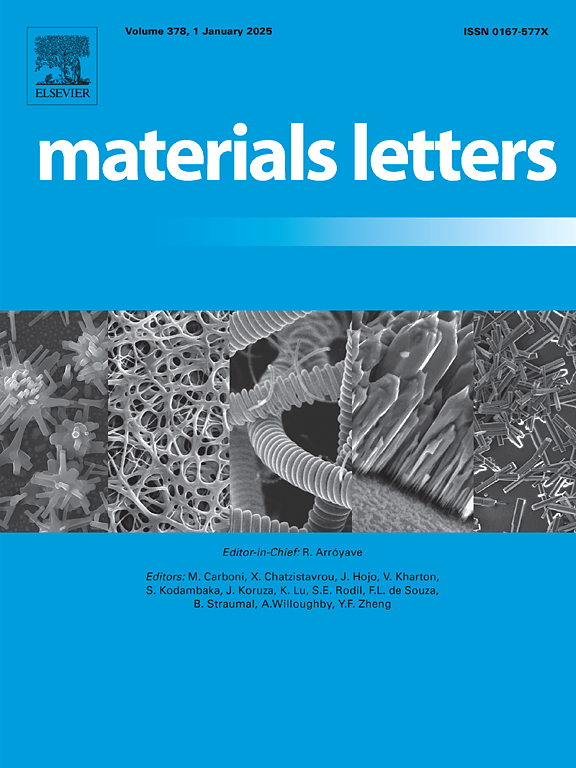The influence of the chemical composition on martensitic transformation, microstructure and superelasticity in NiFeGaCo alloys
IF 2.7
4区 材料科学
Q3 MATERIALS SCIENCE, MULTIDISCIPLINARY
引用次数: 0
Abstract
The chemical composition influences the microstructure, phase composition, martensitic transformation temperatures, and superelasticity of NiFeGaCo alloys. Ni47.5Fe16Ga26.5Co10 and Ni47.5Fe15Ga27.5Co10 alloys exhibited high martensitic transformation temperatures (Ms > 330 K). A [001]-oriented Ni47.5Fe16Ga26.5Co10 single crystal contained a large volume fraction of γ-phase (15 %–20 %), which prevents full reversibility, and superelasticity was observed in a narrow temperature range (423–523 K) with a small reversible strain of 1.5 % and wide stress hysteresis (300 MPa). In contrast, the single-phase Ni47.5Fe15Ga27.5Co10 single crystal demonstrated high-temperature superelasticity over a wide temperature range (from 373 to 573 K and above) with a large reversible strain (up to 5.5 %), low critical stresses (from 37 MPa at 373 K), and a narrow stress hysteresis (from 25 MPa at 373 K).
化学成分对NiFeGaCo合金马氏体相变、显微组织和超弹性的影响
化学成分影响NiFeGaCo合金的显微组织、相组成、马氏体相变温度和超弹性。Ni47.5Fe16Ga26.5Co10和Ni47.5Fe15Ga27.5Co10合金表现出较高的马氏体相变温度(Ms > 330 K)。A[001]取向Ni47.5Fe16Ga26.5Co10单晶中含有大量的γ相(15% ~ 20%),这阻碍了材料的完全可逆性,在较窄的温度范围(423 ~ 523 K)、较小的可逆应变(1.5%)和较宽的应力滞后(300 MPa)下观察到超弹性。相比之下,单相Ni47.5Fe15Ga27.5Co10单晶在宽温度范围(373 ~ 573 K及以上)表现出高温超弹性,可逆应变大(高达5.5 %),临界应力低(373 K时为37 MPa),应力滞后窄(373 K时为25 MPa)。
本文章由计算机程序翻译,如有差异,请以英文原文为准。
求助全文
约1分钟内获得全文
求助全文
来源期刊

Materials Letters
工程技术-材料科学:综合
CiteScore
5.60
自引率
3.30%
发文量
1948
审稿时长
50 days
期刊介绍:
Materials Letters has an open access mirror journal Materials Letters: X, sharing the same aims and scope, editorial team, submission system and rigorous peer review.
Materials Letters is dedicated to publishing novel, cutting edge reports of broad interest to the materials community. The journal provides a forum for materials scientists and engineers, physicists, and chemists to rapidly communicate on the most important topics in the field of materials.
Contributions include, but are not limited to, a variety of topics such as:
• Materials - Metals and alloys, amorphous solids, ceramics, composites, polymers, semiconductors
• Applications - Structural, opto-electronic, magnetic, medical, MEMS, sensors, smart
• Characterization - Analytical, microscopy, scanning probes, nanoscopic, optical, electrical, magnetic, acoustic, spectroscopic, diffraction
• Novel Materials - Micro and nanostructures (nanowires, nanotubes, nanoparticles), nanocomposites, thin films, superlattices, quantum dots.
• Processing - Crystal growth, thin film processing, sol-gel processing, mechanical processing, assembly, nanocrystalline processing.
• Properties - Mechanical, magnetic, optical, electrical, ferroelectric, thermal, interfacial, transport, thermodynamic
• Synthesis - Quenching, solid state, solidification, solution synthesis, vapor deposition, high pressure, explosive
 求助内容:
求助内容: 应助结果提醒方式:
应助结果提醒方式:


